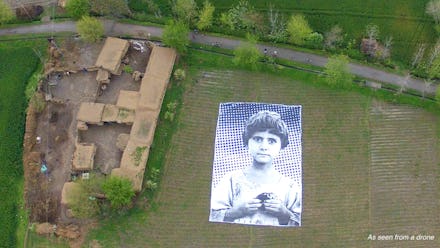Giant Artwork Shows Drone Operators the Faces of Their Targets

Operators of predator drones are trained killers, but the only view they have of their target is on a grainy screen in a control room thousands of miles away. From this absurd displacement stems the phrase "bug splat," because killing someone on a small screen is, to the drone operators, no more connected to something human than crushing an insect.
To combat this insensitivity, as well as raise awareness about civilian casualties, an art collective placed a giant portrait of a child facing upward in the Khyber Pakhtunkhwa region of Pakistan, a frequent ground for drone strikes.
Titled #NotABugSplat, the portrait, when viewed by a drone camera, shows the face of a child staring back, not a nameless dot on a grainy landscape.
Launched two weeks ago by Reprieve UK and The Foundation for Fundamental Rights, in collaboration with an artists' collective associated with French artist JR's Inside Out Project, the poster was unrolled among mud huts and farms of an undisclosed village in the KPK province.
"The piece was left there for as long as people decided to use the fabric for roofing and other useful purposes. The art was always meant to be utilized and not discarded after it was photographed," Saks Afridi, a New York-based artist and former advertising creative who is handling media enquiries for the group, told BuzzFeed.
According to the Foundation for Fundamental Rights, the child in the portrait is nameless but is a victim of a drone attack that killed both her parents and two young siblings.
The installation is also designed to be captured by satellites, in order to make it a permanent part of the landscape on online mapping sites. The purpose of the installation, the organization hopes, is to serve as an enduring reminder of the results of drone strikes on civilians, and to stimulate debate among policymakers on the consequences of using them.